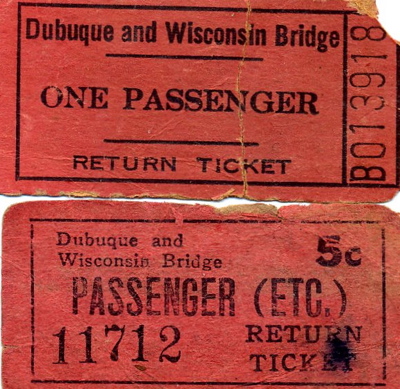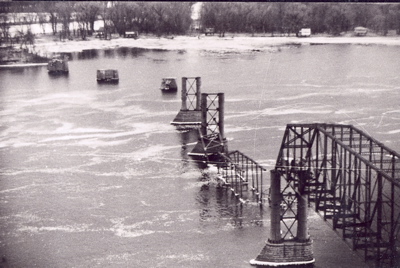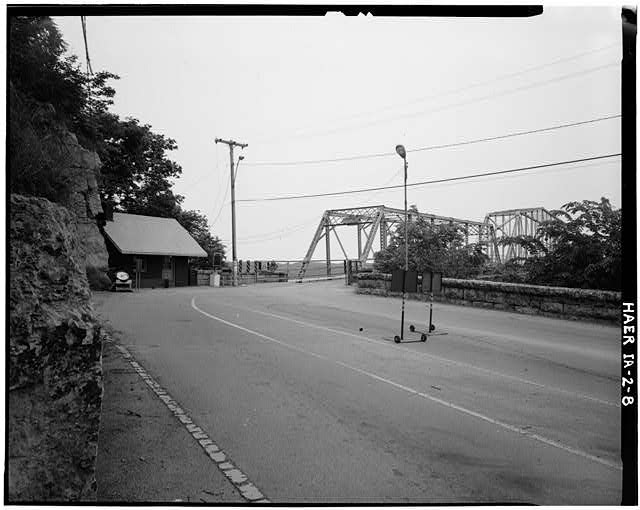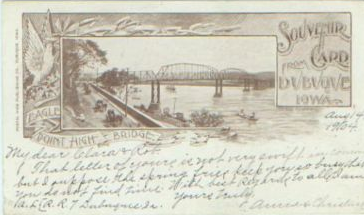Encyclopedia Dubuque
"Encyclopedia Dubuque is the online authority for all things Dubuque, written by the people who know the city best.”
Marshall Cohen—researcher and producer, CNN
Affiliated with the Local History Network of the State Historical Society of Iowa, and the Iowa Museum Association.
EAGLE POINT BRIDGE: Difference between revisions
No edit summary |
No edit summary |
||
| Line 17: | Line 17: | ||
[[Image:imp257.jpg|left|thumb|250px|Toll ticket. Photo courtesy: Bob Reding]]Toll takers working for the Dubuque-Wisconsin Bridge Company worked twelve hour split shifts. | [[Image:imp257.jpg|left|thumb|250px|Toll ticket. Photo courtesy: Bob Reding]]Toll takers working for the Dubuque-Wisconsin Bridge Company worked twelve hour split shifts. | ||
In 1922 the east approach to the Eagle Point high bridge was renovated. Structural steel was used to replace the wooden structure at a cost of $25,000. Work was done so that traffic moving in either direction was not affected. (7) Painting the bridge in 1926 took over four hundred gallons of paint with the most difficult part being the inverted fifth span. (8) In 1928 the wooden joists of the bridge were replaced with steel girders and the floor was replaced. With the steel girders, the carrying weight of the bridge increased to twenty tons. The new flooring was composed of creosoted wooden planks covered with tarvia and stone. ( | In 1922 the east approach to the Eagle Point high bridge was renovated. Structural steel was used to replace the wooden structure at a cost of $25,000. Work was done so that traffic moving in either direction was not affected. (7) Painting the bridge in 1926 took over four hundred gallons of paint with the most difficult part being the inverted fifth span. (8) The inverted span, according to the bridge company, was used to save money while providing the same structural support. (9) In 1928 the wooden joists of the bridge were replaced with steel girders and the floor was replaced. With the steel girders, the carrying weight of the bridge increased to twenty tons. The new flooring was composed of creosoted wooden planks covered with tarvia and stone. (10) Construction continued in 1935. At that time portions of the east end of the bridge and the entire eastern approach was to be renovated. The work would result in a sharp bend in the bridge being reduced to a gradual bend. The work undertaken by the government was at no expense to the bridge company. (11) | ||
The use of the bridge was reduced in 1969 when both the Iowa and Wisconsin departments of transportation removed the bridge from highway designations. U. S. 151 and 61 were routed to the [[JULIEN DUBUQUE BRIDGE]] and weight limits were imposed on the Eagle Point Bridge. Only cars and pickup trucks were allowed to cross. Semi-trucks had been banned since 1967. Despite this, between three thousand and four thousand vehicles continued to use it daily, many drivers headed for the [[JOHN DEERE DUBUQUE WORKS]] north of the city. ( | The use of the bridge was reduced in 1969 when both the Iowa and Wisconsin departments of transportation removed the bridge from highway designations. U. S. 151 and 61 were routed to the [[JULIEN DUBUQUE BRIDGE]] and weight limits were imposed on the Eagle Point Bridge. Only cars and pickup trucks were allowed to cross. Semi-trucks had been banned since 1967. Despite this, between three thousand and four thousand vehicles continued to use it daily, many drivers headed for the [[JOHN DEERE DUBUQUE WORKS]] north of the city. (12) | ||
Congestion on the bridge led to a proposal in 1974. The [[DUBUQUE AND WISCONSIN BRIDGE COMPANY]] suggested a plan to add a second toll booth and widen the access on the Iowa side. Traffic into Dubuque from Wisconsin would use two lanes and both toll booths in the morning. Traffic to Wisconsin would use one lane and one booth. The pattern would be reversed at night. ( | Congestion on the bridge led to a proposal in 1974. The [[DUBUQUE AND WISCONSIN BRIDGE COMPANY]] suggested a plan to add a second toll booth and widen the access on the Iowa side. Traffic into Dubuque from Wisconsin would use two lanes and both toll booths in the morning. Traffic to Wisconsin would use one lane and one booth. The pattern would be reversed at night. (13) | ||
[[Image:imp262.jpg|left|thumb|300px|Drivers crossing the bridge into Wisconsin purchased a ticket (top). If they picked up a passenger in Wisconsin, a second ticket had to be purchased (bottom).Photo courtesy: Bob Reding]] | [[Image:imp262.jpg|left|thumb|300px|Drivers crossing the bridge into Wisconsin purchased a ticket (top). If they picked up a passenger in Wisconsin, a second ticket had to be purchased (bottom).Photo courtesy: Bob Reding]] | ||
| Line 29: | Line 29: | ||
[[Image:tollbridgedown.jpg|left|thumb|250px|The famous bridge lies in ruin after all attempts to save it failed.Photo courtesy: Bob Reding]] | [[Image:tollbridgedown.jpg|left|thumb|250px|The famous bridge lies in ruin after all attempts to save it failed.Photo courtesy: Bob Reding]] | ||
In 1982, despite suggestions that the bridge be kept open for pedestrian and bicycle traffic and an inspection showing the bridge was structurally and functionally sound, the span was demolished at a cost of $500,000. ( | In 1982, despite suggestions that the bridge be kept open for pedestrian and bicycle traffic and an inspection showing the bridge was structurally and functionally sound, the span was demolished at a cost of $500,000. (14) Iowa officials claimed that the federal government which was paying for the new [[DUBUQUE-WISCONSIN BRIDGE]] would not allow the old bridge to remain. (15) Profits from tolls were used to help pay the cost of demolition. Rumors that the owners would sue to block construction of a new bridge across the river were denied. | ||
[[Image:dbqwiscbridge.jpg|left|thumb|200px|Photo courtesy: Jim Massey]] | [[Image:dbqwiscbridge.jpg|left|thumb|200px|Photo courtesy: Jim Massey]] | ||
[[Image:tollkeeper.jpg|left|thumb|200px|Toll keeper's station. Library of Congress]] | [[Image:tollkeeper.jpg|left|thumb|200px|Toll keeper's station. Library of Congress]] | ||
| Line 58: | Line 58: | ||
8. "Work on Eagle Point Bridge Nearing Completion," Telegraph Herald, October 10, 1926, p. 2. Online: http://news.google.com/newspapers?id=BDVFAAAAIBAJ&sjid=krsMAAAAIBAJ&pg=3294,5681095&dq=eagle+point+bridge&hl=en | 8. "Work on Eagle Point Bridge Nearing Completion," Telegraph Herald, October 10, 1926, p. 2. Online: http://news.google.com/newspapers?id=BDVFAAAAIBAJ&sjid=krsMAAAAIBAJ&pg=3294,5681095&dq=eagle+point+bridge&hl=en | ||
9. "Eagle Point Bridge | 9. Bulkley, John. "Iowa Bidding for Eagle Point Bridge," Telegraph Herald, February 7, 1979, p. 1. Online: http://news.google.com/newspapers?id=D9hBAAAAIBAJ&sjid=LqoMAAAAIBAJ&pg=6949,932970&dq=eagle+point+bridge&hl=en | ||
10. " | 10. "Eagle Point Bridge to Get Improvements," Telegraph Herald and Times Journal, December 17, 1928, p. 2. Online: http://news.google.com/newspapers?id=godFAAAAIBAJ&sjid=pbwMAAAAIBAJ&pg=4051,285914&dq=eagle+point+bridge&hl=en | ||
11 | 11. "Part of Eagle Point Bridge to be Rebuilt," Telegraph Herald, August 4, 1935, p. 23. Online: http://news.google.com/newspapers?id=TLxBAAAAIBAJ&sjid=tqkMAAAAIBAJ&pg=7192,3340237&dq=eagle+point+bridge&hl=en | ||
12. " | 12. Kelly, Steve and Kircher, Steve. "Bridge Repairs Exact Toll in Downtown Traffic," Telegraph Herald, May 22, 1979, p. 1. Online: http://news.google.com/newspapers?id=M-5BAAAAIBAJ&sjid=PqoMAAAAIBAJ&pg=4513,3177103&dq=eagle+point+bridge&hl=en | ||
13. " | 13. "Second Toll Booth and Extra Lane Proposed for Eagle Point Bridge," Telegraph Herald, October 17, 1974, p. 11. Online: http://news.google.com/newspapers?id=-gVRAAAAIBAJ&sjid=Gr8MAAAAIBAJ&pg=7238,4078241&dq=eagle+point+bridge&hl=en | ||
14. Ibid. | 14. "Contract Awarded for Demolition of Eagle Point Bridge," Telegraph Herald, July 11, 1982, p. 4. Online: http://news.google.com/newspapers?id=HJFSAAAAIBAJ&sjid=wNAMAAAAIBAJ&pg=6728,1212934&dq=eagle+point+bridge&hl=en | ||
15. Ibid. | |||
Revision as of 21:12, 3 December 2013
This entry is being edited.
EAGLE POINT BRIDGE. In 1894 Joseph A. RHOMBERG organized the DUBUQUE AND WISCONSIN BRIDGE COMPANY to construct a bridge into Wisconsin from Dubuque. In 1900 Senator William Boyd ALLISON introduced the necessary bill in Congress stating that the bridge would be constructed near EAGLE POINT and that it would not be constructed within two miles of any other bridge. The direction would be a responsibility of the Secretary of War and work was to be completed within three years of the passage of the bill. (1)
The first money was solicited in 1894. By August 1899, company officials had gathered $15,000 in subscriptions from farmers in Wisconsin and were about to begin a subscription process on the Iowa side. They were able to state that the project was already a financial success. (2) This was affirmed at the end of October when over $50,000 of the total $100,000 needed for construction had been subscribed in Wisconsin and only the Fifth Ward of Dubuque. A city-wide subscription was being planned. (3) When the company had achieved all the money necessary for the project, the Dubuque city council awarded $25,000 as a bonus. (4)
Plans were changed. In 1899 E. R. Shankland, a civil engineer and contractor who worked on the Chicago World's Fair, arrived in Dubuque and decided to move the location of the bridge six hundred feet north of the original proposal. (5) The river commission in 1900 decided that the three spans would each be 350 feet wide. Shankland then had to redraw plans on submit them to an engineer in Rock Island for approval. (6) The eastern portion of the bridge was made of wood instead of the iron used on the western side. The bend in the bridge near the Wisconsin side was used to save additional money. The bridge stretched from Eagle Point to an area in Wisconsin formerly known as Kimball's Slough or KIMBALL'S PARK. The 1,100 foot long bridge had 1,800 feet of trestle extending into Wisconsin.
The opening of the bridge was not celebrated as might have been expected. Bridge company officials chose not to invest their money in a ceremony, it was reported, because of the cost of the bridge. No reason was given for the fact that the Dubuque Retailer Association abandoned its plans for a celebration.
Pedestrian crossings costing five cents began on May 3rd although the bridge was not opened for teams of horses until May 6th. Mrs. George Gantenbein was the first to pay the twenty-five cent toll to drive a team of horses with a load of produce to the Central Market.
Although organized celebrations failed, the opening of the bridge did create local interest. On May 18th an estimated five thousand people crossed the new bridge in answer to a plan of the DUBUQUE SAENGERBUND. The fraternal organization announced May 18th as the day for Dubuque residents to cross the bridge into Wisconsin for a day of beer drinking and dancing at Kimball's Park.
The four-ton weight limit of the bridge often terrified timid motorists who ventured over its steel-grating deck. Rhomberg had hopes of running trolley cars across it, a dream never accomplished.
Toll takers working for the Dubuque-Wisconsin Bridge Company worked twelve hour split shifts.
In 1922 the east approach to the Eagle Point high bridge was renovated. Structural steel was used to replace the wooden structure at a cost of $25,000. Work was done so that traffic moving in either direction was not affected. (7) Painting the bridge in 1926 took over four hundred gallons of paint with the most difficult part being the inverted fifth span. (8) The inverted span, according to the bridge company, was used to save money while providing the same structural support. (9) In 1928 the wooden joists of the bridge were replaced with steel girders and the floor was replaced. With the steel girders, the carrying weight of the bridge increased to twenty tons. The new flooring was composed of creosoted wooden planks covered with tarvia and stone. (10) Construction continued in 1935. At that time portions of the east end of the bridge and the entire eastern approach was to be renovated. The work would result in a sharp bend in the bridge being reduced to a gradual bend. The work undertaken by the government was at no expense to the bridge company. (11)
The use of the bridge was reduced in 1969 when both the Iowa and Wisconsin departments of transportation removed the bridge from highway designations. U. S. 151 and 61 were routed to the JULIEN DUBUQUE BRIDGE and weight limits were imposed on the Eagle Point Bridge. Only cars and pickup trucks were allowed to cross. Semi-trucks had been banned since 1967. Despite this, between three thousand and four thousand vehicles continued to use it daily, many drivers headed for the JOHN DEERE DUBUQUE WORKS north of the city. (12)
Congestion on the bridge led to a proposal in 1974. The DUBUQUE AND WISCONSIN BRIDGE COMPANY suggested a plan to add a second toll booth and widen the access on the Iowa side. Traffic into Dubuque from Wisconsin would use two lanes and both toll booths in the morning. Traffic to Wisconsin would use one lane and one booth. The pattern would be reversed at night. (13)
When the bridge was purchased by the State of Iowa in 1979 for $769,000, part-time help was hired, and shifts ran eight hours long. The state paid overtime to the toll-takers and paid extra for working on holidays. While the bridge company paid neither of these benefits, employees usually received a Christmas bonus of several hundred dollars something not paid by the state. During the first eight months the state owned the bridge, it took in $272,000 against expenses of $66,673.
In 1982, despite suggestions that the bridge be kept open for pedestrian and bicycle traffic and an inspection showing the bridge was structurally and functionally sound, the span was demolished at a cost of $500,000. (14) Iowa officials claimed that the federal government which was paying for the new DUBUQUE-WISCONSIN BRIDGE would not allow the old bridge to remain. (15) Profits from tolls were used to help pay the cost of demolition. Rumors that the owners would sue to block construction of a new bridge across the river were denied.

See: DUBUQUE PONTOON BRIDGE COMPANY
---
Source:
1. "Eagle Point Bridge," Dubuque Daily Herald, January 19, 1900, p. 8. Online: http://news.google.com/newspapers?id=RhhBAAAAIBAJ&sjid=cKgMAAAAIBAJ&pg=3001,7141367&dq=eagle+point+bridge&hl=en
2. "Eagle Point Bridge," Dubuque Daily Herald, August 11, 1899, p. 8. Online: http://news.google.com/newspapers?id=bwhBAAAAIBAJ&sjid=OagMAAAAIBAJ&pg=2078,4934833&dq=eagle+point+bridge&hl=en
3. "The Eagle Point Bridge," October 29, 1899, p. 8. Online: http://news.google.com/newspapers?id=BRhBAAAAIBAJ&sjid=cKgMAAAAIBAJ&pg=2934,1607339&dq=eagle+point+bridge&hl=en
4. "They Vote $25,000," Dubuque Daily Herald, November 5, 1895, p. 8. Online: http://news.google.com/newspapers?id=qrBFAAAAIBAJ&sjid=LL0MAAAAIBAJ&pg=3137,6288801&dq=eagle+point+bridge&hl=en
5. "Eagle Point Bridge," August 11, 1899"
6. "Eagle Point Bridge, Dubuque Daily Herald, June 14, 1900, p. 8. Online: http://news.google.com/newspapers?id=XyNBAAAAIBAJ&sjid=kagMAAAAIBAJ&pg=2229,991149&dq=eagle+point+bridge&hl=en
7. "Push Eagle Point Bridge Project," Telegraph Herald, Sept. 10, 1922, p. 1. Online: http://news.google.com/newspapers?id=xahjAAAAIBAJ&sjid=js0MAAAAIBAJ&pg=4652,109136&dq=eagle+point+bridge&hl=en
8. "Work on Eagle Point Bridge Nearing Completion," Telegraph Herald, October 10, 1926, p. 2. Online: http://news.google.com/newspapers?id=BDVFAAAAIBAJ&sjid=krsMAAAAIBAJ&pg=3294,5681095&dq=eagle+point+bridge&hl=en
9. Bulkley, John. "Iowa Bidding for Eagle Point Bridge," Telegraph Herald, February 7, 1979, p. 1. Online: http://news.google.com/newspapers?id=D9hBAAAAIBAJ&sjid=LqoMAAAAIBAJ&pg=6949,932970&dq=eagle+point+bridge&hl=en
10. "Eagle Point Bridge to Get Improvements," Telegraph Herald and Times Journal, December 17, 1928, p. 2. Online: http://news.google.com/newspapers?id=godFAAAAIBAJ&sjid=pbwMAAAAIBAJ&pg=4051,285914&dq=eagle+point+bridge&hl=en
11. "Part of Eagle Point Bridge to be Rebuilt," Telegraph Herald, August 4, 1935, p. 23. Online: http://news.google.com/newspapers?id=TLxBAAAAIBAJ&sjid=tqkMAAAAIBAJ&pg=7192,3340237&dq=eagle+point+bridge&hl=en
12. Kelly, Steve and Kircher, Steve. "Bridge Repairs Exact Toll in Downtown Traffic," Telegraph Herald, May 22, 1979, p. 1. Online: http://news.google.com/newspapers?id=M-5BAAAAIBAJ&sjid=PqoMAAAAIBAJ&pg=4513,3177103&dq=eagle+point+bridge&hl=en
13. "Second Toll Booth and Extra Lane Proposed for Eagle Point Bridge," Telegraph Herald, October 17, 1974, p. 11. Online: http://news.google.com/newspapers?id=-gVRAAAAIBAJ&sjid=Gr8MAAAAIBAJ&pg=7238,4078241&dq=eagle+point+bridge&hl=en
14. "Contract Awarded for Demolition of Eagle Point Bridge," Telegraph Herald, July 11, 1982, p. 4. Online: http://news.google.com/newspapers?id=HJFSAAAAIBAJ&sjid=wNAMAAAAIBAJ&pg=6728,1212934&dq=eagle+point+bridge&hl=en
15. Ibid.











